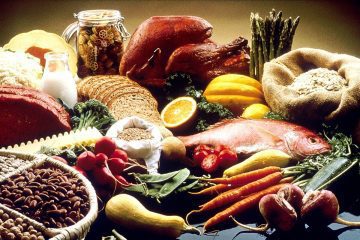Table of Contents
- Understanding the Cost of Living in Korea: A Comprehensive Overview of Food Expenses
- Essential Strategies for Crafting a Monthly Food Budget in Korea
- Exploring Traditional Korean Cuisine: Affordable Ingredients and Meal Ideas
- Navigating Grocery Shopping in Korea: Tips for Smart Spending
- Eating Out on a Budget: Affordable Dining Options and Local Favorites
- Q&A
- Closing Remarks


Understanding the Cost of Living in Korea: A Comprehensive Overview of Food Expenses
When considering the food expenses in Korea, it’s essential to understand the diverse options available, which can greatly influence your monthly budget. Eating out is a popular choice, with everything from street food to dining at upscale restaurants. A typical street meal can cost around ₩3,000 to ₩7,000 (approximately $2.50 to $6), while a meal at a mid-range restaurant may set you back ₩10,000 to ₩20,000 ($8 to $17). For those who prefer dining at home, grocery prices vary depending on the type and quality of the ingredients. Local markets generally offer more affordable prices compared to larger supermarkets.
Here’s a breakdown of typical grocery costs you might encounter in Korea:
| Grocery Item | Average Cost (₩) |
|---|---|
| Rice (1 kg) | ₩3,000 |
| Chicken Breasts (1 kg) | ₩8,000 |
| Eggs (10 count) | ₩4,000 |
| Vegetables (1 kg) | ₩2,500 |
| Milk (1 liter) | ₩2,000 |
Additionally, many Koreans rely on convenience stores for quick meals or snacks, which is reflected in their food budgeting. Convenience store meals such as kimbap or instant noodles often range from ₩2,000 to ₩5,000 ($1.70 to $4.20), making them an excellent and affordable choice for students and busy professionals alike. It’s worth noting that factors like location and lifestyle can significantly alter your food expenses; urban areas like Seoul and Busan may present higher costs compared to smaller cities. Ultimately, understanding these dynamics will help you tailor your food budget effectively and enjoy the rich culinary landscape Korea has to offer.


Essential Strategies for Crafting a Monthly Food Budget in Korea
Creating a food budget in Korea requires a blend of local knowledge and strategic planning. Understanding the pricing dynamics of different regions can significantly influence your monthly expenses. For instance, groceries tend to be more affordable in larger markets such as E-Mart or Homeplus than in convenience stores. It’s wise to explore surrounding neighborhoods to identify smaller markets that may offer local goods at lower prices. Regularly visiting these markets not only helps save money but also allows you to discover seasonal produce and traditional ingredients that can enhance your meals.
To effectively manage your monthly food budget, consider pre-planning your meals. This practice not only curtails impulse purchases but also ensures you utilize what you already have at home. Making a weekly menu can simplify your shopping trips. Create a shopping list based on these meals to avoid buying unnecessary items. Here’s a simple format for a meal plan:
| Day | Meal | Key Ingredients |
|---|---|---|
| Monday | Bibimbap | Rice, vegetables, egg, gochujang |
| Tuesday | Kimchi Jjigae | Kimchi, tofu, pork, scallions |
| Wednesday | Samgyeopsal | Pork belly, lettuce, garlic, ssamjang |
Another essential strategy is to take advantage of discounts and seasonal sales. In many Korean supermarkets, products nearing their expiration date are often marked down, offering significant savings. Keep an eye out for promotions, especially before holidays or weekends when families stock up for gatherings. Participating in local community markets can also yield fresh and inexpensive produce. Don’t hesitate to make friends with vendors; they may offer tips on the best deals or upcoming discounts, thus enhancing your shopping experience while keeping your budget intact.


Exploring Traditional Korean Cuisine: Affordable Ingredients and Meal Ideas
Traditional Korean cuisine is not only delicious but also offers a variety of affordable ingredients that make it accessible for anyone looking to explore new flavors without breaking the bank. Key staples like rice, kimchi, and tofu are not only budget-friendly but also form the foundation of many Korean dishes. These ingredients boast versatility and can be used in a multitude of recipes. For instance:
- Rice: A perfect base for any meal, it can be served plain or fried.
- Kimchi: This fermented vegetable dish adds flavor and nutrition to your meals and can be made from local vegetables.
- Tofu: A protein-rich ingredient that absorbs flavors, ideal for stews and stir-fries.
Another element that enhances affordability is the accessibility of seasonal vegetables. Korean markets and local grocery stores often feature an array of fresh produce at reasonable prices, enabling home cooks to create hearty meals. Popular vegetables include spinach, zucchini, and carrots, each adding a unique texture and flavor to your dishes. Here are a few meal ideas to inspire your culinary journey:
- Kimchi Fried Rice: A quick and delicious way to use leftover rice and kimchi.
- Vegetable Bibimbap: Combine assorted seasonal veggies over rice with a sunny egg on top.
- Doenjang Jjigae: A flavorful soybean paste stew packed with vegetables and tofu, perfect for a comforting dinner.
To further facilitate budget-friendly cooking, consider making use of bulk purchasing. Ingredients like dried seaweed, sauces, and seasonings can often be bought in larger quantities, reducing the cost per serving. A simple table summarizing some essential bulk items and their approximate costs can guide your shopping:
| Ingredient | Approximate Cost (USD) |
|---|---|
| Dried Seaweed | $5 |
| Korean Red Pepper Paste (Gochujang) | $4 |
| Soy Sauce | $3 |
| Sesame Oil | $6 |
With a bit of creativity and savvy shopping, exploring traditional Korean cuisine on a budget can turn out to be both fulfilling and enjoyable.


Navigating Grocery Shopping in Korea: Tips for Smart Spending
When it comes to grocery shopping in Korea, understanding the local market dynamics can lead to significant savings. First and foremost, familiarize yourself with the various types of grocery stores available. Hypermarkets like E-Mart and Homeplus often have a wider selection and competitive pricing, while traditional markets provide fresh produce and unique items at potentially lower prices. Here’s a quick rundown of where to shop:
- Hypermarkets: Great for bulk buying and everyday essentials.
- Local Markets: Perfect for fresh vegetables, fruits, and specialty foods.
- Convenience Stores: Useful for last-minute purchases but typically more expensive.
It’s also essential to keep an eye out for seasonal sales and promotions. Many stores run discounts on specific categories each week, so planning your shopping around these offers can maximize savings. Additionally, joining a store’s membership program often nets savings and exclusive deals. Create a simple budget to track your grocery expenses and remember to consider each week’s special offers:
| Store Type | Ideal for | Tip |
|---|---|---|
| Hypermarket | Bulk purchases | Look for weekly flyers for deals. |
| Local Market | Fresh produce | Visit early for the best picks. |
| Convenience Store | Quick snacks | Avoid for regular grocery shopping. |
don’t underestimate the power of meal planning. By narrowing down your meals for the week, you can create a shopping list that eliminates unnecessary purchases. This not only helps you to stick to your budget but also reduces food waste. Consider using apps or planners to organize weekly meals and shopping lists efficiently. Utilizing these strategies will help you stretch your food budget further while enjoying all that Korean cuisine has to offer.


Eating Out on a Budget: Affordable Dining Options and Local Favorites
When exploring dining options in Korea without straining your wallet, you’ll be surprised by the variety of delicious and affordable choices that await. The street food scene is one of the most vibrant aspects of Korean culture, offering a range of tasty morsels that cater to any palate. Popular items include:
- Tteokbokki – Chewy rice cakes smothered in a spicy-sweet sauce that captures the essence of street food excitement.
- Gimbap - Korean seaweed rolls filled with rice, vegetables, and proteins, perfect for a hearty yet budget-friendly snack.
- Hotteok – Sweet pancakes filled with brown sugar, cinnamon, and nuts, ideal for a cozy dessert on the go.
If you prefer a sit-down meal, look for local favorites that offer great deals without skimping on flavor. Many eateries serve generous portions at reasonable prices, which can make your dining experience both satisfying and economical. Consider trying:
| Cuisine | Recommended Dishes | Average Price (KRW) |
|---|---|---|
| Korean BBQ | Bulgogi, Samgyeopsal | 8,000 – 12,000 |
| Noodle Shops | Jajangmyeon, Naengmyeon | 6,000 – 9,000 |
| Kimchi Jjigae Restaurants | Kimchi Stew, Rice | 7,000 – 10,000 |
Exploring local markets can also lead you to charming eateries frequented by residents. Check out places that offer set menus or lunch specials—these often provide the best value for your money. Some additional tips for dining out on a budget include:
- Opt for Lunch Specials: Many restaurants provide significant discounts for weekday lunch offerings.
- Share Dishes: Korean dining emphasizes communal eating; sharing a variety of dishes enhances the experience and reduces cost.
- Drink Water: Instead of ordering expensive drinks, enjoy tap water which is usually free.
Q&A
Q&A: Navigating Your Food Budget in Korea
Q1: How much should I budget for food in Korea on a daily basis?A: The daily food budget in Korea can vary depending on lifestyle and eating habits. On average, a budget of about 10,000 to 15,000 KRW (approximately $8 to $12 USD) can cover basic meals at local eateries and street food. If you’re looking for more upscale dining or international cuisine, consider budgeting closer to 20,000 to 30,000 KRW ($15 to $25 USD) per day.Q2: What are some economical dining options I can find in Korea?A: Korea offers a variety of economical dining options. Street food vendors serve delicious, affordable snacks like tteokbokki (spicy rice cakes), gimbap (Korean sushi rolls), and hotteok (sweet pancakes). Traditional markets, such as Gwangjang Market, also offer affordable meal options, where you can savor local dishes without breaking the bank. Additionally, “gukbap” joints and “gamjatang” restaurants often provide hearty meals at reasonable prices.
Q3: Is it cheaper to cook at home or eat out in Korea?A: Cooking at home can be cost-effective, especially for longer stays. Grocery prices in Korea are competitive, and local markets often offer fresh produce at lower prices than supermarkets. However, if you are only in Korea for a short period or don’t have access to a kitchen, eating out might be more convenient and similarly priced, particularly if you opt for budget-friendly eateries.
Q4: How can I save money on groceries in Korea?A: To save money on groceries in Korea, consider shopping at local markets, where prices can be significantly lower than in supermarkets. Additionally, keep an eye out for discount days at major chains like E-Mart or Homeplus. Planning meals around seasonal ingredients and buying in bulk can further reduce your grocery bill. Also, don’t hesitate to try local brands, which often offer good quality at a lower price.
Q5: Are there dietary accommodations for those with specific needs, like vegetarian or gluten-free diets?A: Yes, while Korea is known for its meat-focused dishes, the food scene is evolving to accommodate various dietary preferences. You can find vegetarian and vegan options at many restaurants, especially in larger cities like Seoul. Health food stores and online markets also stock gluten-free products. It may take some effort to locate specific items, but many cafes and restaurants are increasingly aware of dietary restrictions.
Q6: What are some common food-related customs in Korea that I should know about?A: In Korea, sharing is an integral part of the dining experience. Dishes are typically placed in the center of the table for everyone to enjoy. It’s also customary to wait for the eldest person at the table to start eating before you dig in. Additionally, be mindful of chopstick etiquette—never stick them upright in rice, as this resembles a funeral custom.
Q7: How can technology help me manage my food budget in Korea?A: Several mobile apps can assist you in managing your food budget in Korea. Apps like ‘Baedal Minjok’ and ‘Yogiyo’ offer delivery options and often have promotions or discounts. ‘Naver’ and ‘Coupang Eats’ are also excellent resources for comparing prices and finding deals. Moreover, budgeting apps can help you track your daily or weekly spending, making it easier to stick to your budget while enjoying the local cuisine.
This Q&A aims to guide you through creating a balanced and budget-friendly food experience in Korea, allowing you to savor the unique culinary culture without overspending.




0 Comments